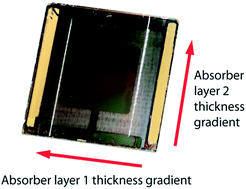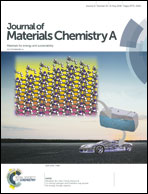Rapid experimental optimization of organic tandem solar cells: 200 absorber layer thickness combinations on a 4×4 cm2 substrate
Abstract
Due to the complex optical field, the optimization of layer thicknesses in organic tandem solar cells is a very time-consuming task which is commonly approached in an iterative sample-by-sample fabrication routine or by preliminary optical simulations. In this work, a facile and comprehensive experimental approach to determine optimized absorber layer thicknesses is presented. Both absorber layers are deposited with orthogonal thickness gradients. The spatially resolved mapping of the device's photocurrent produces more than 200 data points and allows the identification of the optimum layer thickness combination. This two-dimensional optimization process is benchmarked against sample-by-sample and one-dimensional sample optimization. All layers of the tandem solar cells were doctor bladed, eventually enabling the fabrication of a solar module with a photoactive area of 24 cm2 comprising four monolithically connected solar cells, excelling with a power conversion efficiency of 5.2%.



 Please wait while we load your content...
Please wait while we load your content...